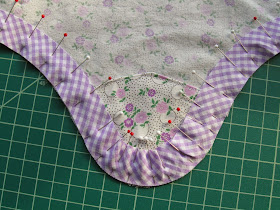1944
If you tell most people to close their eyes and imagine a "vintage apron" this is the apron they'll see in their mind's eye. This apron goes by many names: pinafore apron, bib apron, farmhouse apron, kitchen apron, full coverage apron, work apron, church ladies' apron. The pattern companies have always offered this style of apron for their customers, though in the last 15 years or so the style has been called out more as a vintage or retro offering than work wear.
This particular pattern shows up on eBay pretty regularly. There may be several reasons for this. It may have been considered a good teaching pattern for Home Economics classes. For some wartime industrial jobs, this type of apron would have been acceptable work wear. If the pattern companies reduced their new offerings during World War II, women might have had fewer choices when they went to buy an apron pattern. I have two copies of this apron pattern. One is pristine and unused. And then there is this one, which I thought was much more interesting.
This pattern has had a very productive life. Both the envelope and the pattern pieces have seen a lot of use. This was somebody's favorite apron pattern - or perhaps the maker had neither the desire nor the means to replace a perfectly functional pattern. I suspect she made aprons for her own use.
Observing the way a pattern has been used almost allows us to hear the maker's voice:
"I never cut that little facing piece for the back - too much trouble."I decided to start the new year by making myself a new apron, and I chose to use this pattern more or less as it was provided, using the pattern pieces for the fiddly facing bits and the strings, but not the pepper appliques - my whimsy goes only so far! The fabric is a remnant I've had in my stash for years, and regular readers will recognize the lavender gingham bias binding from an enormous quantity I cut a few years ago and use regularly.
"I don't know why you'd need to a pattern piece for the strings - they're just rectangles, and anyway, I like mine narrower/wider/longer/shorter."
"I don't pay any attention to the grain line for the lower back piece - I just line up the back edge along the selvage - it's faster that way.""
"Why would I want to spend time putting those pepper appliques on a work apron?"
Here's that facing piece (on the right; the upper back apron is on the left.)
This pattern specifies one inch binding - eight yards of it, finishing to 1/4 inch. My current sewing machine doesn't have a binder attachment, and I don't trust myself to sew the binding on in one pass, so I pinned and sewed it first to the back, then folded to the front, pressed and pinned again, and finally sewing down on the front. This is one of my very least favorite sewing operations, but I do love the look of the end result.
As usual with McCall patterns, this printed pattern was very accurate and went together very well.
Note the horizontal slashed dart in the side fronts to add bust fullness. You can see on the inside where I've left in my yellow gathering stitches.
Although the instructions didn't call for it, I topstitched this dart for added strength.
Here's the completed apron, just before its maiden voyage to the kitchen. I'm afraid it'll never look this nice again:
Here it is opened out, showing that it would be relatively easy to iron (if one were so inclined.)
The back is fastened with a single vintage shell button from my stash.
I've been wearing this apron for kitchen work for about two weeks now, and I find it very comfortable. I think I understand why the pattern was used so much.











